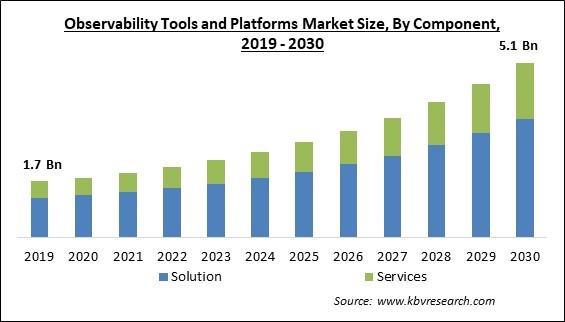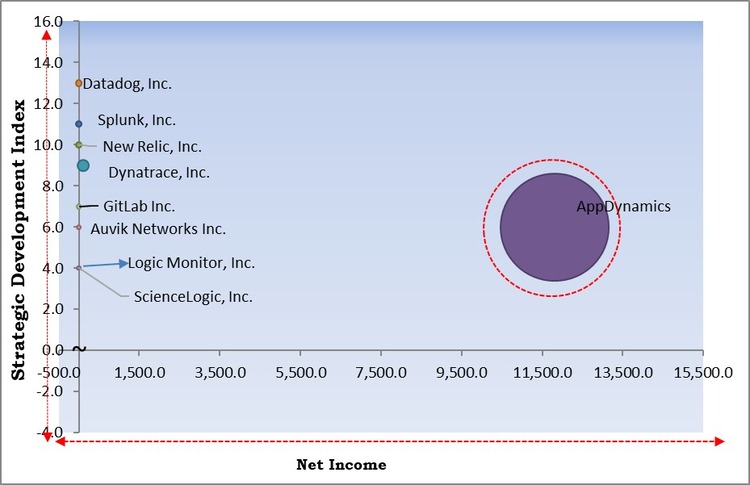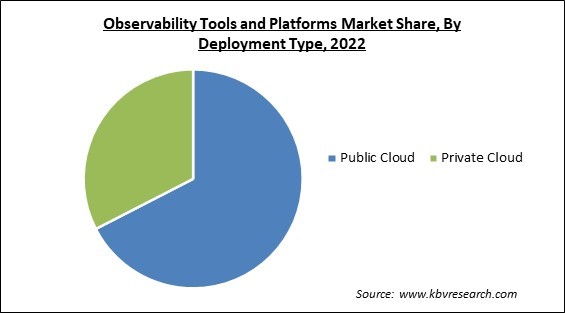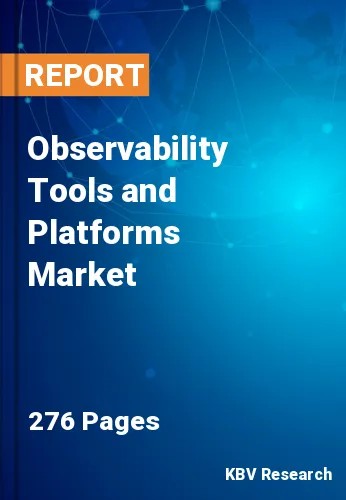The Global Observability Tools and Platforms Market size is expected to reach $5.1 billion by 2030, rising at a market growth of 12.3% CAGR during the forecast period.
Data observability provides the data pipeline with an assurance layer of protection by evaluating the data quality and warning companies of expected data outages. Therefore, the BFSI segment would capture approximately 1/4th share of the market by 2030. It has been noted that data may sometimes be insufficient, inaccurate, in error, or out of date. Additionally, data fire drills, a human process, can be time-consuming and expensive. Through operational tools and platforms visibility, guardrails, proactive, timely alerts, and resource reduction, the data observability solution assists businesses in the BFSI vertical in scaling data and analytics platforms. It also helps to maximize data quality while minimizing data outages by monitoring data reliability across frequent transformations.

The major strategies followed by the market participants are Acquisition as the key developmental strategy to keep pace with the changing demands of end users. For instance, In February 2023, LogicMonitor acquired Airbrake to extend LogicMonitor’s ITIM platform into developer environments and would allow customers to gain visibility into continuous integration and deployment (CI/CD) workflows. In August 2022, Datadog, Inc. completed the acquisition of Seekret to extend Datadog's unified platform to provide deeper API observability, governance, and automation in the complete API lifecycle.
Based on the Analysis presented in the KBV Cardinal matrix; AppDynamics is the forerunner in the Market. In January, 2022, AppDynamics LLC took over Opsani to offers Cisco an expert in the continuous optimization field. Companies such as Datadog, Inc., Splunk, Inc., New Relic, Inc. are some of the key innovators in the Market.

The cloud-based monitoring platform enables organizations to measure the effectiveness of their cloud-based apps and services being monitored and demonstrated. In order to avoid vendor lock-in, end users prefer cloud services from a variety of vendors. For example, businesses use public cloud services from suppliers like Amazon, Microsoft, and Google to store irrelevant data. In contrast, private cloud or on-premises systems are preferred to keep sensitive information. As a result, observability tools and platforms reduce vendor lock-in while streamlining the management of a multi-cloud and hybrid environment without sacrificing control over crucial resources. The market is expected to expand as cloud-based solutions become more widely used.
The ability to collect and analyze data that can result in insights used to generate actionable income is one of the primary benefits of digital transformation for businesses. Previously, data had been spread across several irrelevant platforms or worse, information might have yet to be gathered and used. The digital revolution also accelerates the speed at which information is generated and transmitted. Businesses can respond rapidly to new trends, news, and discussions by utilizing observability tools and platforms with real-time monitoring capabilities, which promotes agile decision-making. It is anticipated that as the digital transition accelerates, there will be an increase in demand for observability tools, which will drive market growth.
Tools for observability rely on accurate and consistent data to provide insights. Factors like data replication delays or data storage mechanism variations may cause data inconsistencies during application portability. Tools that can manage these inconsistencies and give a clear view of application performance are necessary. Cloud vendors could have restrictions while transferring workloads from one cloud environment to another. As a result, workloads are restricted to the single cloud provider on which they were built. Consequently, maintaining high performance and cost-efficiency while changing workloads or apps from one environment to another becomes a key challenge for cloud vendors.

The leading players in the market are competing with diverse innovative offerings to remain competitive in the market. The above illustration shows the percentage of revenue shared by some of the leading companies in the market. The leading players of the market are adopting various strategies in order to cater demand coming from the different industries. The key developmental strategies in the market are Acquisitions.
Based on deployment type, the market is fragmented into public cloud and private cloud. The private cloud segment garnered a significant revenue share in the market in 2022. Low latency is a feature of private clouds. The agility of a private cloud is increased through DevOps and cloud-native techniques. Because private cloud gives companies more control over their cloud environment, many organizations prefer to use them. Their environment can be scaled up or down according to requirements, and their employees can access a highly accessible cloud dedicated to a single organization. Since private clouds offer a significant advantage, they let businesses employ chargeback technologies at a particular level.

On the basis of component, the market is segmented into solution and services. The solutions segment dominated the market with the maximum revenue share in 2022. The observability platform offers tools for assessing, evaluating, and managing cloud services, applications, and infrastructure. It provides features like comprehensive cloud visibility, eliminating blind spots early issues, vulnerability detection to secure the cloud, more significant insights, cost control, fast troubleshooting, and performance tracking across the cloud. Additionally, observability solutions are created for businesses of all sizes, and the monitoring tool may scale in parallel with the growth of cloud activity. Also, these solutions are offered on a subscription basis, which lowers operational costs. Future demand for the solutions is anticipated to be fueled by these benefits.
By verticals, the market is classified into BFSI, energy & utilities, government & public sector, IT & telecom, education, retail & consumer goods, healthcare, and others. The retail and consumer goods segment recorded a remarkable revenue share in the market in 2022. The retail and consumer goods segment benefits from data observability because it decreases the time it takes to identify problems with data quality and boosts income by using reliable and trustworthy data. The retail & consumer goods segment has benefited from data observability in several ways, including custom alerting for well-known business logic, such as the frequency of updating third-party data, field-level lineage graphs that help show the effects of changes down the line, and automated thresholding for data quality metrics across critical tables.
| Report Attribute | Details |
|---|---|
| Market size value in 2022 | USD 2.1 Billion |
| Market size forecast in 2030 | USD 5.1 Billion |
| Base Year | 2022 |
| Historical Period | 2019 to 2021 |
| Forecast Period | 2023 to 2030 |
| Revenue Growth Rate | CAGR of 12.3% from 2023 to 2030 |
| Number of Pages | 276 |
| Number of Table | 383 |
| Report coverage | Market Trends, Revenue Estimation and Forecast, Segmentation Analysis, Regional and Country Breakdown, Competitive Landscape, Market Share Analysis, Companies Strategic Developments, Company Profiling |
| Segments covered | Component, Deployment Type, Vertical, Region |
| Country scope | US, Canada, Mexico, Germany, UK, France, Russia, Spain, Italy, China, Japan, India, South Korea, Singapore, Malaysia, Brazil, Argentina, UAE, Saudi Arabia, South Africa, Nigeria |
| Growth Drivers |
|
| Restraints |
|
Region wise, the market is analysed across North America, Europe, Asia Pacific, and LAMEA. In 2022, the North America region generated the highest revenue share in the market. Due to its technological advancement and development, North America has the most modern technologies for monitoring and tracking devices. The widespread adoption of multi-cloud and hybrid cloud installations throughout the region has been driven by years of significant technological adoption. Due to the large number of players providing observability tools and platform solutions and services in North America, the market there is mature and growing favorably.
Free Valuable Insights: Global Observability Tools and Platforms Market size to reach USD 5.1 Billion by 2030
The market research report covers the analysis of key stakeholders of the market. Key companies profiled in the report include AppDynamics, Dynatrace, Inc., Splunk, Inc., Logic Monitor, Inc., SolarWinds Corporation, Datadog, Inc., ScienceLogic, Inc., Auvik Networks Inc., New Relic, Inc., and GitLab Inc.
By Component
By Deployment Type
By Vertical
By Geography
This Market size is expected to reach $5.1 billion by 2030.
Growing utilization of cloud-based solutions are driving the Market in coming years, however, Portability of applications is challenging restraints the growth of the Market.
AppDynamics, Dynatrace, Inc., Splunk, Inc., Logic Monitor, Inc., SolarWinds Corporation, Datadog, Inc., ScienceLogic, Inc., Auvik Networks Inc., New Relic, Inc., and GitLab Inc.
The expected CAGR of this Market is 12.3% from 2023 to 2030.
The Public Cloud segment is leading the Market by Deployment Type in 2022; thereby, achieving a market value of $3.4 billion by 2030.
The North America region dominated the Market by Region in 2022 and would continue to be a dominant market till 2030; thereby, achieving a market value of $1.7 billion by 2030.
Our team of dedicated experts can provide you with attractive expansion opportunities for your business.

